What is gender history?
1/19
There's no tags or description
Looks like no tags are added yet.
Name | Mastery | Learn | Test | Matching | Spaced |
|---|
No study sessions yet.
20 Terms
Women’s history is influenced by feminist exper. & thought, often by desire to contrib. to social change.
origins 👩’s history
Virginia Woolf’s 📚 A Room of One’s Own
Enormous class & gender barriers to who was able to record their words
(1928 lecture to Newnham College, Cambridge) ‘A woman must have money & a room of her own if she is to write fiction’
‘To have a room of her own, let alone quiet room or a sound-proof room, was out of the question
lessher parents were exceptionally rich/ very noble, even up to the beg. of the 19thC’
👩 had been able to contrib. to fiction in gen. & ↑ gen. historical record throughout history ∵ lacked (creative) space (& privacy their own room), time & funds to do so (fund their creativity).
👩
never had anyth. to saybut that 👩 had never been able to express it.
Imagined what would have happened to Shakespeare’s sister, had she existed, travelled to London to try to write plays w/same talent Shakespeare.
Even she
would have been able to express it∵ contemp. gender restrictions.
Imagines being in her library @ 🏠, looking around for 📚 there.
👩’s contrib. to their work recogn. by historic record.
Able to ∵ classs & gender barriers.
Nature work they put in: heavily ephemeral, everyday lab. that facilitated their partners’ succ. in contrib. tow. it (so heavily laboured upon)

origin 👩’s history
against Woolf
Mary Wollstonecraft
1 first proto-feminist texts = The Vindication of the Rights of Woman (1792)
Argued women’s apparently weak & passive nature owed more to social rules than their physical make-up.
already by 1700s: idea women being conditioned by sit. around themselves; view that gender = social construct; femininity is not biological but determined by way raised.
proto-socialist → analysed it ← class perspective
→ contrib. women to FR
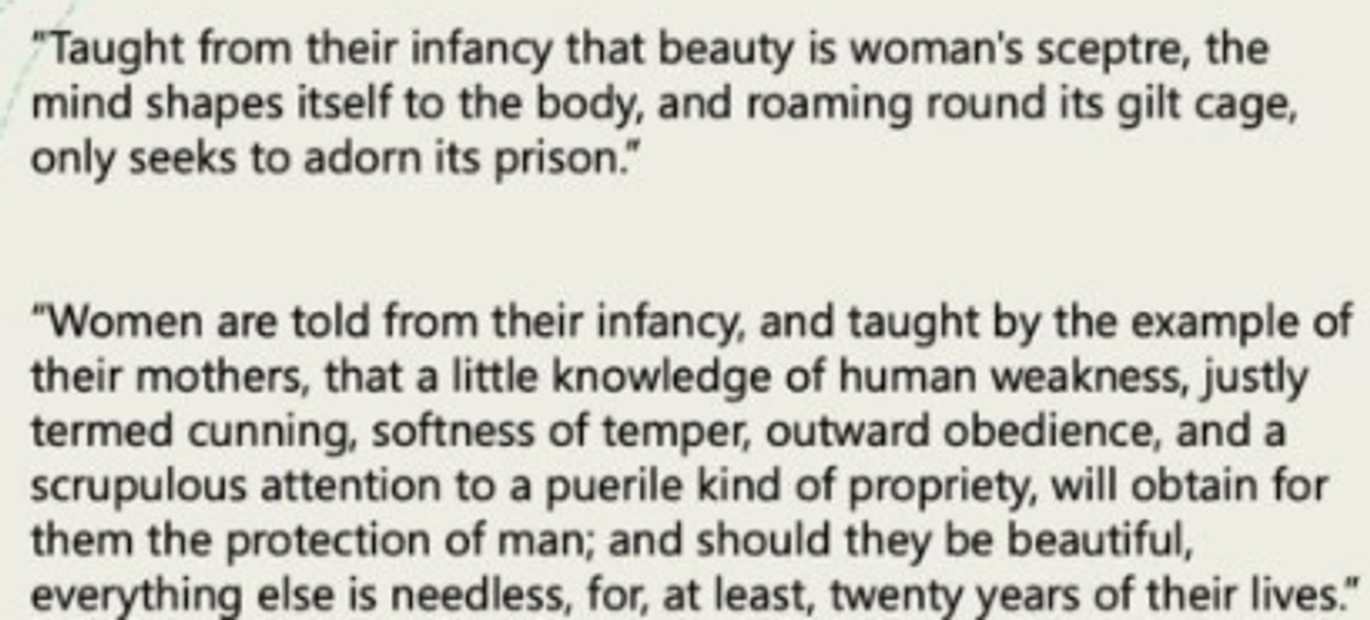
origin 👩’s history
against Woolf
Olympes de Gouges
Wrote foundational text on freedom man: La Declaration de droits de la femme et de la citoyenne (Aug. 1791)
Opened w/’Man, are you capable of being fair? A woman is asking: at least you will allow her that right. Tell me?
Woolf wrong - women w/certain class privileges were writing foundational texts on their rights, calls to arms in 18thC (though was she? These were aristocratic, UC women)
origin 👩’s history
What did WH grow out of?
2nd wave feminism 1960s
feminist activity groups & WLM
push for women’s emancip. & equality w/men(← 1973)
London Feminist History Group
(← 1973) Network women working on women’s history, includ. visitors ← abroad. Typically 15-30 women in each session. community
ANNA DAVIN in History Workshop Journal 1980 article: described it as ‘an informal discussion group amongst women committed to women’s liberation and working on historical questions, mostly (but not all) as graduate students’
grassroots collective
WHY? To prov. supp. & inspiration
To supp. each other because found weren’t receiving that support within academy - members academy hostile/ unsympathetic (supervisors/students not sympathetic to issue feminist history, often antagonistic to feminist subjects of research shows for choosing it)
Mostly women
women felt that they were only able to express their ideas w/o embarrassment w/o men in the space
"There are subjects we can explore without embarrassment which would be difficult with men present, there are theoretical questions of women's consciousness and the nature of feminist history which it is useful to be able to develop as a women's group (even though sometimes of
course they will be discussed with -male comrades), and there is a solidarity we experience as a group of
feminist women historians that would be weakened by the presence of men."
BUT some men could come, e.g. Jeffrey Weeks who lectured on history sexuality

WH lacking intersectionality…
Increasing interest in women’s contrib. & exper., includ. ← lab. history POV, looking at lives WC women
Often excluded ← that is history of women of colour
→ case looking for women within history: history of women/ women writing history
What are the problems w/studying WH?
Joan Scott sugg. look. ↑ broadly @ category gender itself, rather than just emphas. WH…
👩 exist independently as a field - so much can be gained ← studying interaction 2 genders.
Implies 👨’s history = neutral baseline; the general. Anyth. diverting ← that = gender history. Idea 👩 as the marked gender.
Simone de Beauvoir
Women are told the viewpoint that have is because they are a woman → maybe men also have certain viewpoints because they are a man?
Women have uterus & to say that their views are because of their hormones overlooks fact men also have hormones and sexual hormones.
→ women’s body seen as a hindrance; men’s objective
→ idea male history/POV objective is inherently ridiculous
‘one is not born a woman, one becomes one’
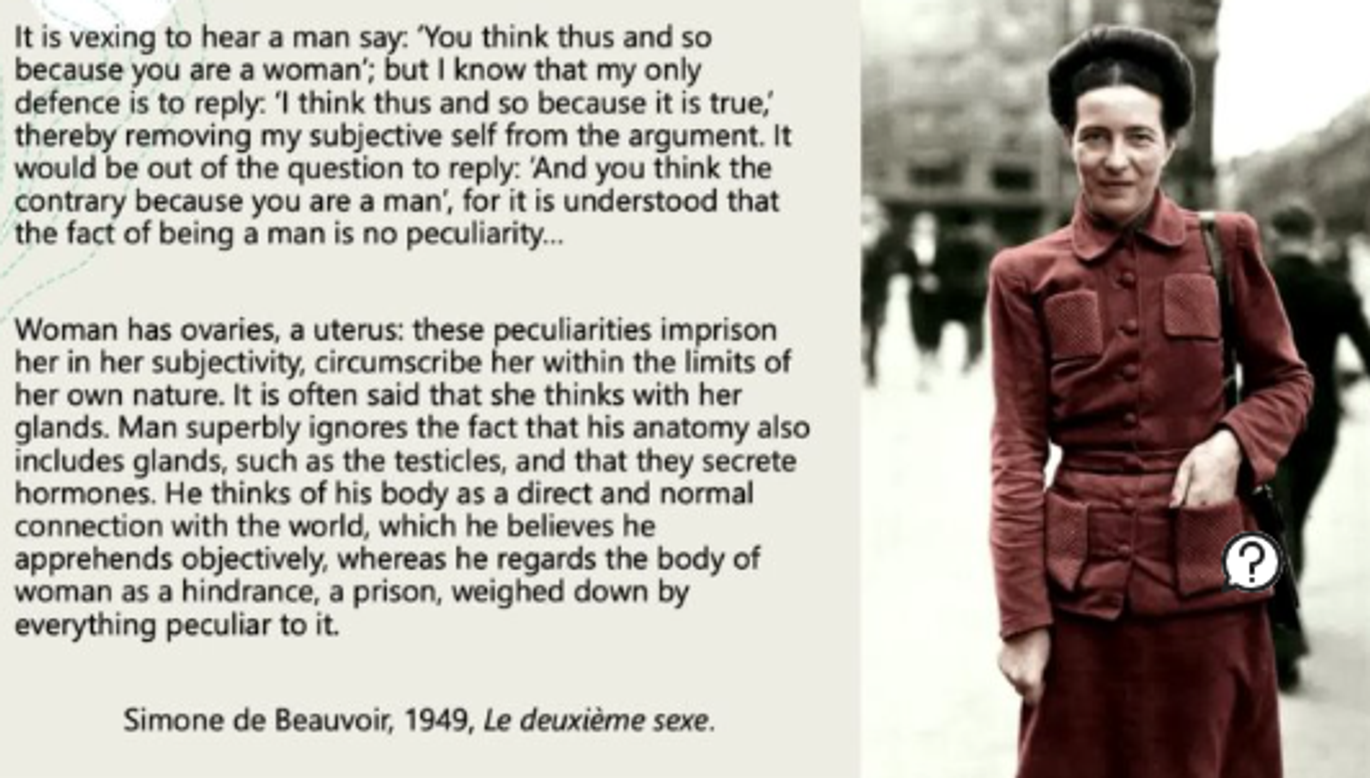
What is gender?
Multidimensional construct referring to rel. bet. 🧍’s physical characteristics, the way 🧍 perceive themselves & how they express that identity.
(Joan Scott)
Constitutive element social relationships based on perceived differences bet. sex…
Involves 4 interrelated elements
Culturally avail. symbols evoke multiple (& often contradictory) representations (e.g. Eve & Mary as symbol women in Western ✝) + myths light & dark, purification & pollution, innoc. & corruptions.
Historian asks which symbolic representations are invoked, how & in what concepts?
Normative concepts that set forth interpretations meanings symbols, that attempt to limit & contain their metaphoric possibilities.
Expressed in religions, educational, scientific, legal & political doctrines
Typically take form fixed binary opposition, categorically & equivocally asserting meaning male & female, masculine & feminine.
Depend on refusal/ repression altern. possibilities + (somet.) overt contests ab. them take place (historians ask @ what moments & under what circumstances).
Merely include/constructed through kinship(household & family) but also lab. market (sex-segreg. lab. market part proc. gender construction, educ. (all-male, single sex or coed. institutions part same proc.) & polity (univ. male suffrage part proc. gender construction), which now (at least in our soc.) operate largelydependentlykinship).Subjective identity
Historians must examine ways in which gendered identities substantively constructed & relate their feelings to range activities, social organisations & historically spec. cultural representations.
poss. through both biographies & collective treatments
Primary way signifying relationships power.
Only fieldbut persistent & recurrent way enabling signification power in West, in Judeo-Christian & Islamic traditions.Not belong 2nd of 1st because whilst concepts power may build on gender,
alw. literally ab. gender itselfEstablished as objective set references, concepts gender structure perception & concrete & symbol. organ. all social life (ref. 41).
To extent these references est. distributions power (differential control over/ access to material & symbolic resources), gender → implicated in conception & construction power itself.
It is not sexuality which haunts society, but society which haunts the body’s sexuality. Sex-related differences between bodies are continually summoned as testimony to social relations & phenomena that have nothing to do w/sexuality. Not only as testimony to, but also testimony for - in other words, as legitimation’ (ref. 42)
These interpretations based on idea conceptual languages employ differentiation to est. meaning + sexual difference = primary way signifying differentiation (ref. 47).
When historians look for ways in which concept gender legitimises & constructs social relationships, they develop insight into reciprocal nature gender & society & into partic. & contextually spec. ways in which politics constructs gender & gender constructs politics.
→ socially and historically constructed
gender as social construct
(1940s) Gendered constructs/ gendered socialisation
Existentialist Simone de Beauvoir: one is not born a woman but becomes a woman
Being a woman not the result of a nat. fact but history: no biological, psychological destiny defines what a good woman is.
Way women raised (history of her life, partic. her childhood) shapes them into a woman, into femininity
(1980s)
Catherine Hall & Leonore Davidoff (1987)
Masculinity & femininity are constructs specific to historical 🕑 & place. They are categories continually being forged, contested, reworked and reaffirmed in social institutions and practices as well as a range of ideologies
Argued same thing: masculinity & femininity specifically constructed within certain times & places; contin. to be forced; are worked, reaffirmed.
Work in relation to each other.
Ideas ab. gender aren’t universal but are alw. a product of their time & the societies in which they are being circulated
Innate reasonwhy societies should be organised ↺ biological sexGender orders have emerged
inevitable/ innateAttributes gender
fixed.
Tak. inspiration ← intellectuals like Michael Foucalt, Scott came to this ← social constructionist view (argued ideas like race, gender, class mean anyth. in themselves; agreed upon, MADE & just occur naturally)
Understanding gender as a social construct make it unimportant. Diminish impact gender. Gender has material consequences for 🧍 in 🌍.
gender is social construct but has v/real impact
Gender history has been 1 most important facets of historical scholarship over the last 50 years.
(since 1970s & 80s)
(David Cannadine) Its arrival has been greatest developm. in entire discipline history since WWII.
What is the rel. bet. women’s history & gender history?
Though hugely influenced by feminist historical approaches, GH merely attempt to ‘reclaim’/ ‘rediscover’ voices & experiences of historical 👩 (inserting 👩 into diff. historical narratives/past)…
Why?
What is gender history?
Joan Scott
Just use gender as ‘thing’ to study but as key methodology: a lens/ ‘useful category of analysis’ that can offer important perspectives & challenges in alm. every aspect of historical scholarship (everyone has gender ∴ gender impacts everyone’s actions)
Gender history “insists on the need to examine gender concretely & in context & to consider it a historical phenomenon, produced, reproduced, & transformed in different situations & over 🕑”
Interrogates concept gender; reanalysing these histories to consider how soc. considered gender, the power equality that occurred as a result, what gender roles meant and how that might have changed.
Lens to examine history - how gender has been made, shaped, regulated, resisted, and experienced in the modern world.
Unpacking categories gender, thinking ab. how gender gets created & transformed → what it looks like in diff. places & diff. times (women/men existed & it was like this… → how did women/men/other genders exist? How did they relate to each other; understand themselves? What did it mean?)
How women understand themselves in relation to other women, etc
reading against the grain - what diff. terms used at time, etc
Importantly, it will also begin to familiarise students with some of the theoretical questions that have influenced modern gender history, including critical introductions to ideas about masculinity and femininity; of feminism and ideas about gender equality; about the intersection of gender with class, race, and sexuality; as well as trans histories and how we might think of gender beyond the binary.
How can we historicise this?
gender expression - how people navigated confines gender
fashion & clothing → fashion/ dress history is growing area gender history (how people navigated what they felt they were supposed to do)
literature authored by men & women
art - things meant to provoke disgust or erotic reaction (John Burgess’ Ways of Seeing - way we looked at/ body identity central to understanding gender → male gaze (see A-Level notes)
How might using gender as an analytical category change our view of history?
Feminist historians claimed women’s scholarship would fundamentally transform disciplinary paradigms.
Study of women adds new subject matter + forces critical re-examination premises & standards existing scholarly work.
Gender is needed as a category of analysis (class & race fail).
Feminist historians increasingly looking for usable theoretical formulations.
Need for synthesising perspective can explain continuities & continuities + account for persisting
equalitiesas well as radically diff. social experiences.Discrepancy bet. high-quality recent work women’s history & its contin. marginal status in field reveals limits descriptive approaches address displinary concepts in terms can shake their power & perh. transform them (see picture)
→ we must use gender as analytic category, lens through which to see world
must understand gender in causal way (theorises ab. nature phenomena/ realities, seek. understanding of how & why these take the form they do.
Gender history involves men too → more nuanced way understanding how men & women act the way they do (hegemonic masculinity…) see later fc
e.g. idea capitalism = product masculine domination
role masculinity within imperial expansion
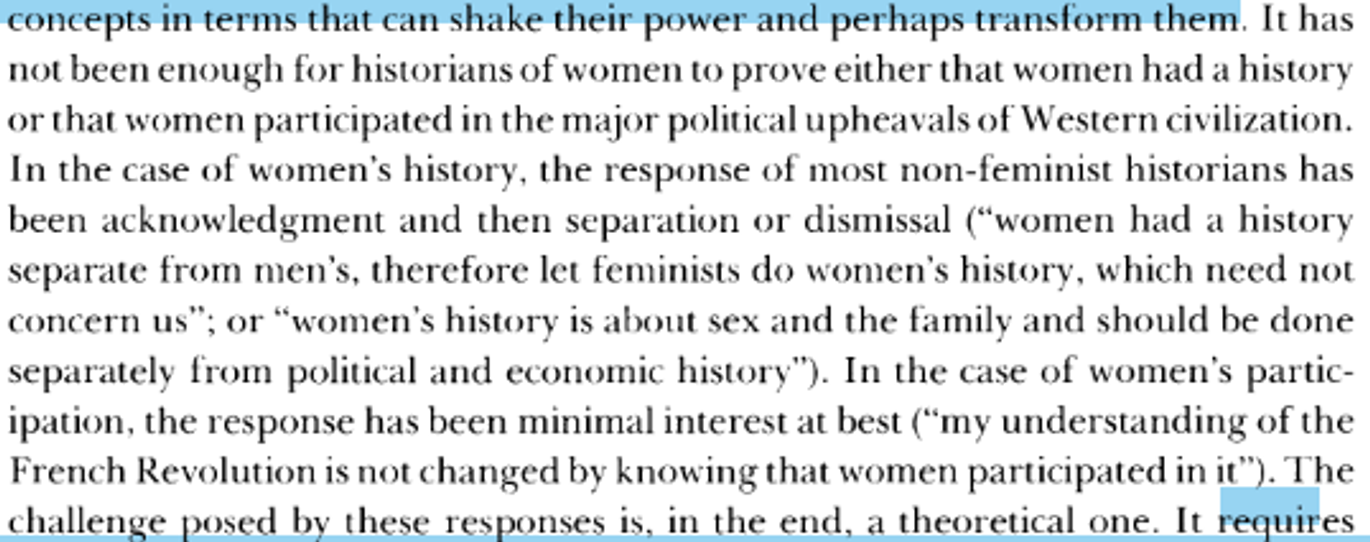
(Joan Scott) challenges GH
Black feminist woman 1999 (Laura Davis…): race, class & gender cannot be separated - chall. having to consider other elements
Only looking through lens gender (e.g. white feminist history), erasing race & class, only getting privileged white woman view - think relationally.
We should not just consider 1 ‘category of analysis’
intersectional feminism → thus limiting history to gender lens is restrictive, ignoring fact people experience things through multiple levels privilege
Joan Scott: our ideas gender change over time - in present day, even within culture, diff. understandings gender (or are there? e.g. essentialism espoused often by geneticists/biology)
link to not projecting modern feminist values & girl-bossing & creating women heroes when they don’t exist (issue w/revionist history more broadly)
we also don’t want great woman’s history
Is this possible? Matter of interest for historians writing (Lucy Crone at Open University).
category intersex reveals biology not binary
What challenges did women face in ‘the academy’ (academia)?
Many female historians still struggle within university/academic spaces to be taken seriously by male historians (mansplaining)
(Solnit) Every woman knows what I’m talking about. It’s the presumption that makes it hard, at times, for any woman in any field; that keeps women from speaking up and from being heard when they dare; that crushes young women into silence by indicating, the way harassment on the street does, that this is not their world. It trains us in self-doubt and limitation just as it exercises men’s unsupported overconfidence.
have own research mansplained to them
male historians explain how hard it it to be male historian, elab. diff. ways in which hard for each of them to be a male historian (enthusiasm male historians to bemoan thier own outsider status)
explaining what history is
When E. H. Carr asked and answered this question, he did so by crafting a discipline populated entirely by men: ‘The historian is of his own age, and is bound to it by the conditions of human existence … the use of language forbids him to be neutral.’7 Carr was himself of his own age, and male historians now concede that female historians exist, at least theoretically. But their citation practices often do not. Male historians explain their fields and their topics, often, through reference to other men; they are less willing, or able, to do so by citing women. As Sara Ahmed has written, citation is both a scholarly and a political act: ‘Citation is how we acknowledge our debt to those who came before,’ and citations can thus sustain or undermine structures & ‘institutions of patriarchal whiteness’.8 And when male historians choose to explain topics, or concepts, or whole fields, through reference only to other (white) men, that exclusion is an intensely political act. Adrienne Rich wrote about the moment of ‘psychic disequilibrium’ that comes when someone with authority ‘describes the world and you are not in it’.9 This psychic disequilibrium has been experienced by many women, who have found their work written out in the explanations of male historians.
This can be especially cutting when male historians explain the ways in which their own work is ground-breaking and original: the gaps that they identify in the field are, often, merely the spaces where women’s work goes unseen. Lucy Robinson has written about the difficulty of being a feminist historian who is committed to kindness and collaboration, but working in a wider discipline that does not value these things, which leads to the jarring experience of listening to other historians describing a ‘hole’ in the existing research that is, in fact, the space in which you know your own work sits.10 Many a female historian has been surprised to hear a male historian explaining his invention of a field, in which she has been working for some time, perhaps her whole career.
Intersectional
These two parties and these two books point up different experiences. First, the experience of not having your expertise taken seriously, because you are a woman, and a man has therefore assumed that your expertise cannot possibly compare to his. Second, the experience of feeling out of place, of knowing that it is only an accident of social mobility that has ended up with you in this room talking about your expertise, and the constant, gripping anxiety that you might one day be found out. And so, women from working class backgrounds suffer from two related maladies. Men explain things to us, even things that we know well, even things in which we are experts, without embarrassment and without holding back. And our own instinct is to let these men explain these things, because deep down we are anxious that maybe, really, they do know more than us, and that we might soon be exposed as frauds.
Academia still hostile space for those who don’t fit into trad. framework of what it means to be an acadmic.
Of course, the academy is an ivory tower, a closed shop, and it can be a very hostile space for anyone who does not fit into the traditional framework of what it means to be an academic. Despite its liberal image and its notions of itself as a tolerant and diverse space, gender, class, race and sexual orientation can all be barriers to an academic career and to feeling accepted and included within academia’s hallowed walls.
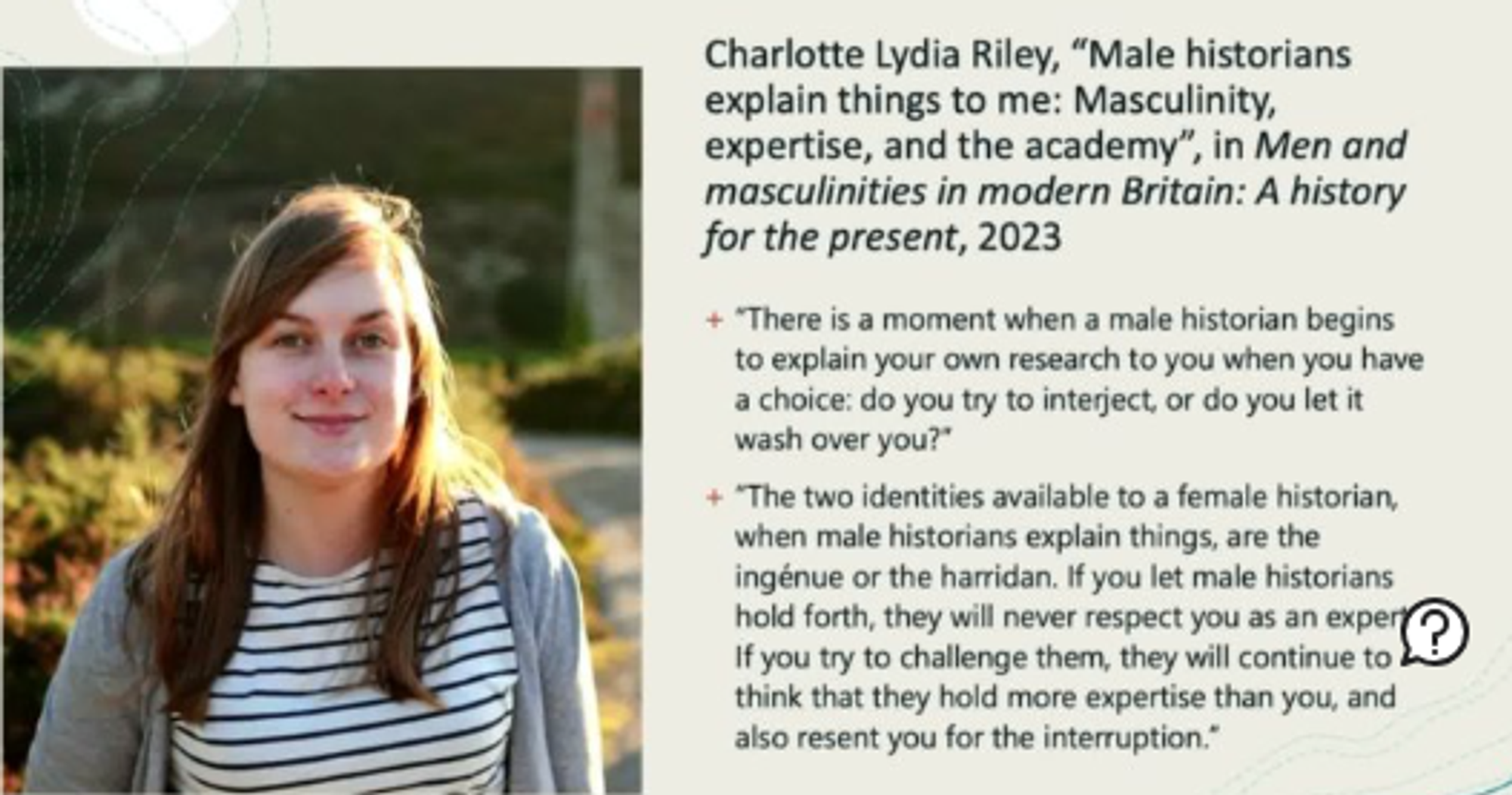
Gender history includes interrogating concept masculinity.
(60s) concept inserting women into history
(80s) interrog. what GH & what gender even means
(90s & 2000s) consid. mascul. as its own history
(Gisela Bock, 1989) 1st issue Gender & History
Pursuit ‘restoring women to history’ soon → that of ‘restoring history to women’
but should just restore women to history - should speak relationally ab. how sexes relate to anoth. (sugg. ‘thinking in relation’):
Not only must we study the relations bet. the sexes, but also the relations within the sexes, not only those of women to men, & of men to women, but also relations among women & among men.
John Tosh
Considered how masculinity impacted the lives men, e.g. arguing GB late C19, men turned their back on domestic sphere & turned tow. assert. themselves in BE to enforce their own masc.
way consid. how men often striv. to assert their masculinity in repository world.
Michael Roper
Used cultural sources to examine emotional histories masc. & utilise psychoanalysis, ← 1990s onwards.
reflecting tensions bet. women’s/feminist/gender history - maybe man will impede interrogation
this historian has never been comfortable w/study masculinity outside relational framework (not just relationships bet. men & women but also bet. diff. kinds men & masculinities, generations, ethnicities, class, race across life courses diff. types man…
intersectionality integral to developm. gender history; consid. these diff. categories vastly impacts diff. experiences gender
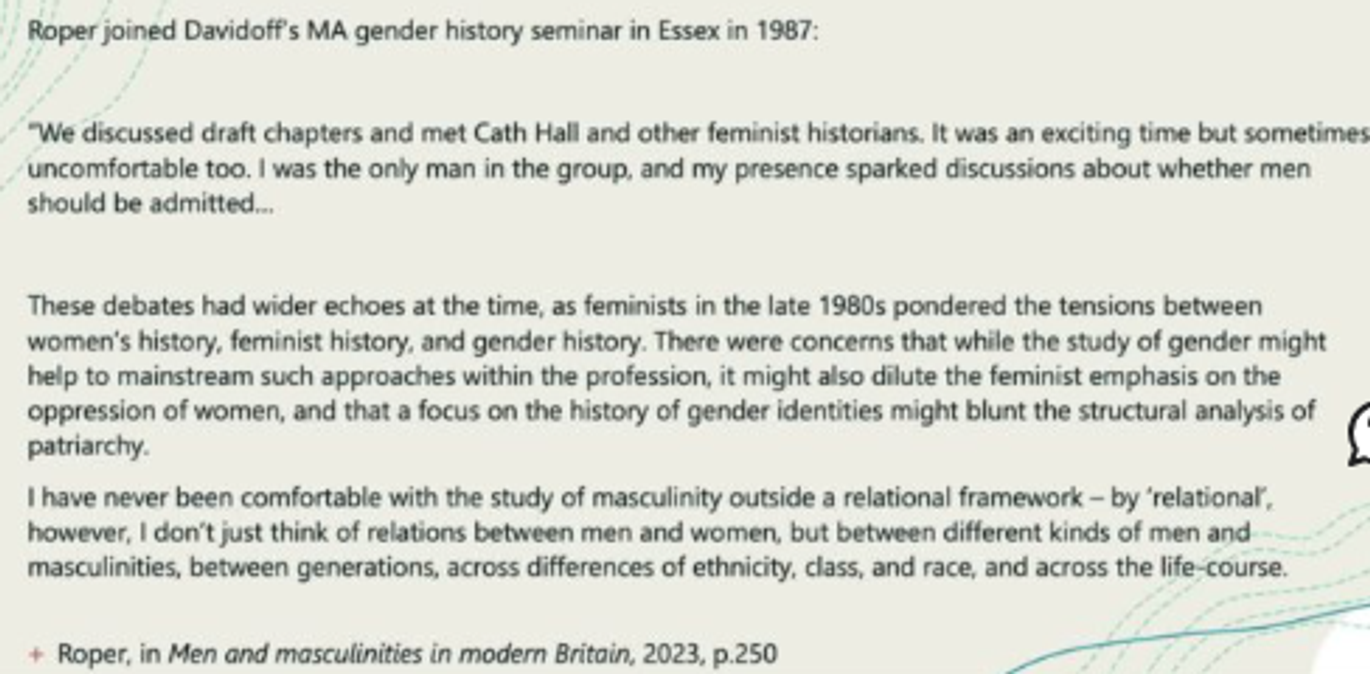
hegemonic masculinity
Who?
R. W. Connell
What?
Theoretical concept: way understand. domination 👩 & a hierarchy of inter♂ dominance (hierarchy within masculinity). All masculinities sup. to feminism.
James Messerschmidt
Hegemonic masculinitiy is the culturally idealised form of masculinity in a given historical & social setting. It is culturally honoured, glorified - such as at the broader societal level (e.g. through the mass media) & at the institutional level (e.g. in school) & is constructed in relation to ‘subordinated masculinities’ (e.g. homosexuality’ & in relation to women
When?
1995 (based on Gramscian ideas cultural hegemony)
Where?
Patriarchal societies, changes depending on societies & cultures but present in most.
Why?
Because of the cycle it creates.
Why important in historiography?
(in contrast to femininity) masculininity within those studies tended to be presented as singular & static other - complicated, existed in slightly caricatured/ really simplistic way
What is the ideal form of masculinity in a society? The masculinity that a society values most?
All masculinities 👓n as equal. Under conditions social equality, 👨 also stratified against each other
Society/culturally honours & glorifies certain types masculinity through:
mass media (film, TV, social media)
institutions |(🏫s, unis, workplaces)
Culturallly honoured masc. often includes…
Being white, cisgender, able-bodied, heterosexual, MC or economically powerful; gay, disabled WC… men lower down pecking order masculinity (espec. men because most feminine)
Masculinity’s status often determined by how far aw. it is ← femininity (hegemonic masculinity defined by characterisitcs most opposed/ in contrast to to femininity).
Only minority men enjoy these patriarchal privileges & power
Even privileged men must conform to spec. behaviours to maintain societal approval. Certain behaviours accepted & idealised (get societal approval), whilst others demonised.
e.g. men aren’t supposed to cry/ drink cocktails
These hierarhcies don’t just exist at broad societal level (nation/ culture) but also with other communities - in any given community, might be multiple hierarchies operating at once (village/ within partic. demogrphic group: young people - hegemonic might look diff. to them in relation to old people).
How does this still → masc. dominance?
Masculinity constructed relationally:
by push. aw. subordinated masculinities (homosexuality)
in relation to 👩
Dictates 👨’s behaviour (& 👩’s too, whether that’s hegemonic feminity or hegemonic masc. (these are rules taken on board by 👩 as way to lead in feminism type way for 👩 to assert themselves)
Dictates 👨’s relationships w/other men, hierarchies bet. them.
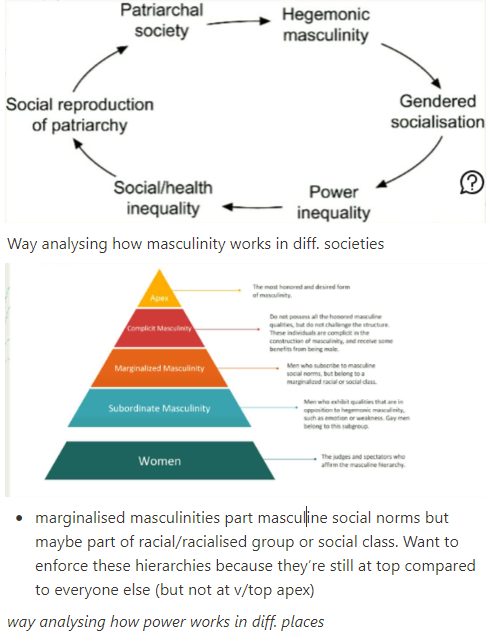
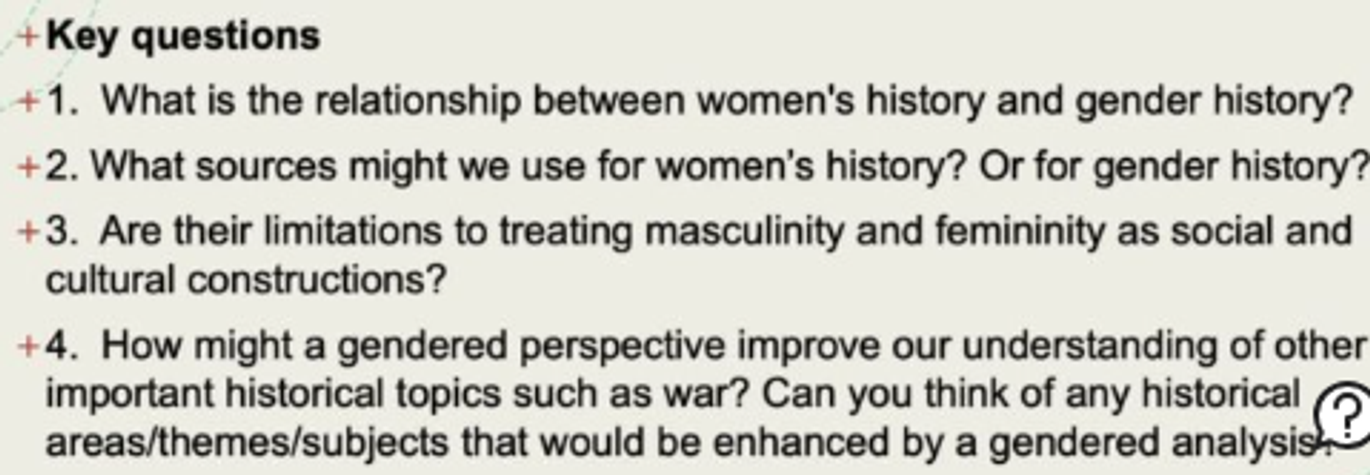
Also includes more consid. relationships bet. diff. genders.
Hence concept gender implies history in gen. must also be seen as gender history, since everybody has some form gender.
what sources might we use for women’s history?
oral records e.g. police records, court minutes… - to get illiterate, poorer women
journals for lliterate, MC women that have been preserved
Wollstonecraft